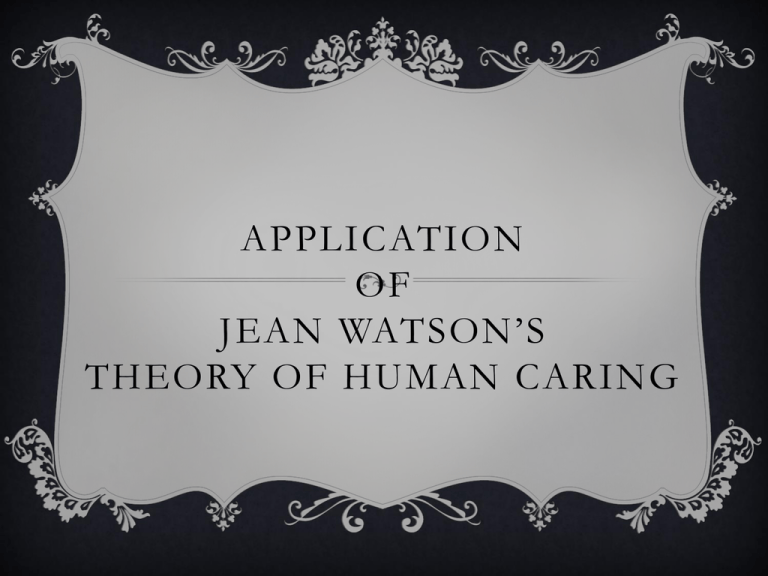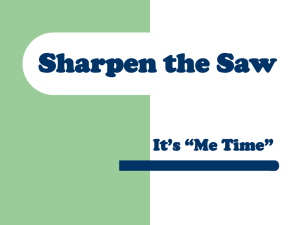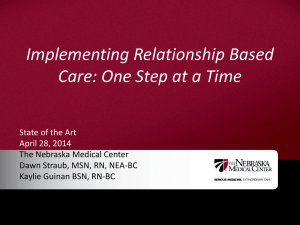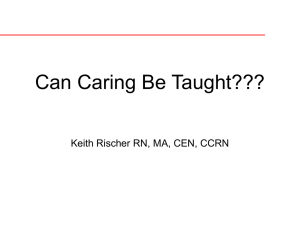Application of Jean Watson`s Theory of Human Caring
advertisement

APPLICATION OF JEAN WATSON’S THEORY OF HUMAN CARING PRESENTED BY: GROUP ONE FERRIS STATE UNIVERSITY Mary Bierlein Anita Riddle Deanna Warnock Holley West Carolyn Zielinski Theory of Human Caring Ten Carative Factors Ten Caritas Processes Give of self, Instill Faith and Hope, Sensitivity, Authenticity, Expression of Feelings, Satisfaction of Needs first, Healing Environment, allowing for the Unknown Caring moments: If transpersonal connection is spiritual. Spend time with your patients, get to know who they are, not just their disease or illness. “Transpersonal caring relationships are the foundation of the work” (Watson, 2010) Treat patient holistically (Mind, Body, Spirit) First book, Nursing: The Philosophy and Science of Caring was written in 1979. Second book, Nursing: Human Science and Human Care- A Theory of Nursing, was published in 1985 and reprinted in 1988 and 1999. (Alligood, 2010) Why Apply Watson’s Theory? Carative factors represent nursing from other professions. Basic assumptions and carative factors construct the structure of this unique theory. Can be applied following the nursing process. Focus is placed on spiritual, emotional, nurse-patient relationship that meets the higher level of human needs. Can be used to direct and enhance practice. Promotes holistic care. Patient is seen as apart of a family, community, and culture specific to them as a holistic human being. Distinguishes patient as focus of “practice rather than the technology”. (“Jean Watson’s Philosophy”, 2010). Rationale for Use of Jean Watson’s Theory of Human Caring • Strengthen the transpersonal caring relationship between nurse and patient • Improving on the caring life moments that take place between nurse and patient • To provide a “moral/ethical foundation for professional nursing” (Watson, 2011, para. 1) • Integrate art and science into practice Watson’s Theory Explored The Theory of Caring has been researched and applied in many areas including: Hospice and Palliative Care Rehabilitation Emergency Care Geriatrics Long Term Care Specialty Settings Team Building Stress Management Application of Jean Watson’s Theory in Hospice and Palliative Care Perceptions of the most helpful nursing behaviors in home-care hospice setting: Caregivers and nurses (Ryan, 1992) Purpose of Study The Theory of Human Caring states the practice of caring is essential and the foremost important part of nursing and the purpose of nursing is to enhance a person’s sense of well-being by assisting in attainment of harmony among the mind, body, and spirit. This study was intended to determine the validity of Watson’s theory of caring nursing behaviors as perceived by patient’s and benefits or disadvantages of such behaviors (Ryan, 1992, p. 23). Assumptions “Caring is central to nursing Care enhances patients’ quality of life Hospice nursing involves caring” (Ryan, 1992, p. 23). Structure of Study Five Hospice Nurses Twenty Primary Caregivers of Home-Care Hospice Clients Watson’s theory provided framework for this study to convey the importance of nursing behaviors as they are perceived by client and caregivers during end-of-life. This realization can “promote caring and quality of life for terminally-ill patients and their caregivers” (Ryan, 1992, p. 23) Structure Continued “Q-sort of 60 nursing behaviors ranked from most to least helpful was completed (…) during the bereavement period” (Ryan, 1992, p. 22). Criteria for caregivers included death of hospice patient occurring within last two to six months. Caregivers and nurses were chosen randomly using a table of identification numbers. Data Collection “In a Q-sort, the subject is presented with a set of cards on which words, phrases, statements, or other messages are written. The subject is then asked to sort cards according to particular dimension” (Ryan, 1992, p. 24). Sixty nursing behaviors divided into three behavior tiers related to: Patient physical needs, patient psychosocial needs, and caregiver psychosocial needs (Ryan, 1992, p. 25). Score of one through seven given with one being least helpful and seven being most helpful (Ryan, 1992, p. 25). Procedure Institutional Review Board for the Protection of Human Subjects and the Hospice agency granted permission for study conduction (Ryan, 1992, p. 25) “ Caregivers completed demographic data and indicated the amount of pain experienced by the hospice patient prior to completing Q-sort” (Ryan, 1992, p. 25). Findings: Caregiver Perceptions of Ten Most Helpful Nursing Behaviors: Most to Least Category Nursing Behavior Patient’s psychosocial needs Listen to the patient/Listen to what the patient wants Patient’s physical needs Provide patient with the necessary emergency measures if the need arises Caregiver’s psychosocial needs Assure me that the nursing services will be available 24 hours a day, 7 days a week Patient’s psychosocial needs Answer the patient’s questions honestly Patient’s psychosocial needs Talk to the patient to reduce his/her fears Caregiver’s psychosocial needs Provide me with information necessary if a home death occurs Caregiver’s psychosocial needs Answer my questions honestly, openly and willingly Patient’s psychosocial needs Stay with patient during difficult times Patient’s psychosocial needs Assure the patient that nursing services are available 24 hours a day, 7 days a week Patient’s physical needs Teach me how to keep the patient physically comfortable (Ryan, 1992, p. 25) Findings: Caregiver Perceptions of Ten Least Helpful Nursing Behaviors: Least to Most Category Nursing Behavior Caregiver’s psychosocial needs Talk to me about my guilt Caregiver’s psychosocial needs Cry with me Caregiver’s psychosocial needs Help me make funeral arrangements Caregiver’s psychosocial needs Assist me in establishing a method for recording medications Patient’s physical needs Attend the funeral and/or go to the funeral home when the patient dies Patient’s physical needs Teach me how to turn and position the patient Patient’s physical needs Assist me in learning how to change the bed sheets with the patient in bed Caregiver’s psychosocial needs Recognize my need to talk about things unrelated to death Caregiver’s psychosocial needs Help me to face reality in my own way in my own time Caregiver’s psychosocial needs Assure me that the patient can be readmitted to the hospital if necessary (Ryan, 1992, p. 26) Findings: Hospice Nurses’ Perceptions of Ten Most Helpful Nursing Behaviors: Most to Least Category Nursing Behavior Caregiver’s psychosocial needs Assure caregiver that the nursing services will be available 24 hours a day, 7 days a week Patient’s physical needs Teach the caregiver how to keep patient physically comfortable Patient’s psychosocial needs Help the patient to feel safe ventilating anger, sadness, anxiety and other feelings Patient’s psychosocial needs Answer the patient’s questions honestly Patient’s psychosocial needs Listen to the patient/ Listen to what the patient wants Patient’s psychosocial needs Assure the patient that nursing services are available 24 hours a day, 7 days a week Patient’s physical needs Teach the caregiver how to relieve the patient’s symptoms Caregiver’s psychosocial needs Provide the caregiver with the information necessary if a home death occurs Caregiver’s psychosocial needs Help the caregiver to feel safe ventilating anger, sadness, anxiety and other feelings Patient’s psychosocial needs Recognize when the patient needs to talk about death and dying (Ryan, 1992, p. 27) Findings: Hospice Nurses’ Perceptions of Ten Least Helpful Nursing Behaviors: Least to Most Category Nursing Behavior Patient’s physical needs Describe how to keep the patient well groomed Patient’s physical needs Assist the caregiver to provide a clean, neat, environment for the patient Patient’s physical needs Do not encourage the patient to have false hope Caregiver’s psychosocial needs Cry with the caregiver Caregiver’s psychosocial needs Pray with the caregiver Patient’s physical needs Teach the caregiver to prevent long term complications of bed rest Patient’s physical needs Teach the caregiver how to adjust the diet as needed Caregiver’s psychosocial needs Teach the caregiver how to adjust the diet as needed Caregiver’s psychosocial needs Help the caregiver feel safe ventilating anger, sadness, anxiety and other feelings Patient’s psychosocial needs Encourage the patient to hope Patient’s physical needs Teach the caregiver how to give some of the care to the patient (Ryan, 1992, p. 27) Evaluation of Study Limitations: Study group represents small demographic area Broad scope of Q-sort material within small group narrows results of data Does not include pertinent data in relation to where death occurred, type of hospice program, certification of program, and length of care These can be remedied by broadening the study group to include more caregivers and nurses and including other pertinent data. Application of Research This study concludes that psychosocial needs are more important than physical needs to both the nurse and the patient Giving patient and caregiver a survey of nursing behaviors to assess their personal needs may assist the nurse in focusing care according to individualized need Holistic care in the hospice setting necessitates incorporation of caregiver needs along with patient needs Reflection Nursing research into the application of the Theory of Caring in relation to end-of-life care needs to be expanded and updated. Spiritual aspects of humanity are realized through the grieving process and nurses need to be comfortable and open-minded with such topics. Caritas nursing applies to hospice care by encouraging expression of all feelings, faith and hope, and unexplained phenomena Jean Watson’s Theory of Caring 6 spouses and their dying loved ones Life expectancies of 2 weeks-9 months 1 woman and 5 men Ages 46-84 The purpose of this study “was to identify and categorize relatives’ in the care of a dying family member in different care cultures and to develop a theoretical understanding of the involvement (Andershed and Ternestedt, 1999, p. 46). An additional aim of this study was to “determine and discuss the congruence and incongruence between the empirical results and key concepts in Watson’s theory of caring” (Andershed and Ternestedt, 1999, p. 46). Throughout the study similarities were compiled that compared for each individual and between individuals. Patterns were found in regards to the actions and reactions of the individuals. Three patterns or categories were found to define the behavior of the family members with the patients. They are as follows “to know, to be, to do” (Andershed and Ternestedt, 1999, p. 46). Refers to those participants that strove to increase their increase their knowledge and their understanding of their loved ones’ condition and prognosis. They wanted to know what staff was doing for their loved one and what they were going to do as the patient’s condition deteriorated. Not actually stated as one of Watson’s 10 carative factors, maybe due to the fact that Watson assumes that knowing and understanding the patient’s lifeworld is necessary for humanistic care. Referred to the spouses wanting to not only be with their loved ones but be in their loved one’s world wherever that may be. They were “involved at a deeper level in the patient’s world” (Andershed and Ternestedt, 1999, p. 48). This finding is very much related to Watson’s caring theory, wherein transpersonal caring relationships are thought to concern “authenticity of being and becoming, and ability to be present” (Watson, 1987, p. 51). This view is reflected in all 10 of Watson’s carative factors. To be involved, to being present, to being in their loved one’s world-there was an intimacy that was present that had not been present before. In Watson’s “transpersonal caring theory of nursing, the first carative factor is forming and acting from a humanistic-altruistic system of values” (Andershed and Ternestedt, 1999, p. 50.). “To Do” indicates the many practical things that relatives did in caring for their family member. Involves doing what the patient would do if he/she were able. To Do is consistent with Watson’s ninth carative factor, which concerns assisting persons to meet basic needs while preserving their dignity and wholeness. It was concluded that For nurses to be able to guide relatives on the patient’s final journey, it is a prerequisite that the nurse knows what the family/patient wants and can do. A collaboration among these three actors is of the greatest importance if the family is to be involved in the light and support the patient in attaining a dignified death in an often short period of time. Further study is needed in this area (Andershed and Ternestedt, 1999, p. 51). As Developed by Patty Magee, RN, BS, MA JEAN WATSON’S CARITAS THEORY CARITAS THEORY “Connecting Art and Wellness” at Baptist Medical Center South, Jacksonville, FL Focus: art is healing for everyone. Rationale: “Caritas Journey for all Nurse's is to explore every avenue in making patient's comfortable” (http://pattymageeart.blogspot.com, 2009). Using art to deal with stress for patients and staff Unlimited forms of art RESEARCH APPROACH AND FINDINGS IN “THE CARING ARTS PROGRAM” Example: Carative Factor 6 Systematic use of scientific (creative) problem solving caring process. Employees met for creative role play using painting on canvas. Photo courtesy of patty magee, nurse artist at http://pattymageeart.blogspot.com/ LIMITATIONS/CREDIBILITY – THE CARING ART PROGRAM No formal evaluation of program It tends to appeal to “artistic” personalities Has only been tested since 2009 (18 months) The program has received many community awards IMPLICATIONS FOR PRACTICE Applicable caritas’ to patients and staff members Make hospitalization less “institutional” (by displaying art on walls and at bedside, involvement in art as a medium). Allow for multiple artistic venues for creativity Outlet for stress (patients, families, and staff). CRITICAL REFLECTION Using nursing theory can add depth to nursing practice in areas not formally researched. Furthering research on the mind-body connection. Offers a way to explore “non-traditional” nursing. CONNECTING ART AND WELLNESS Photo courtesy of patty magee, nurse artist at http://pattymageeart.blogspot.com/ Rediscovering the Art of Healing Connection by Creating the Tree of Life Poster Teri Britt Pipe, PhD, RN Kenneth Mishark, MD Reverend Patrick Hansen, MA, PCC Joseph G. Hentz, MS Zachary Hartsell, PA-C bravecreatures.com The Study • The goal of this study was to help nurses build meaningful therapeutic relationships with their patients • Patients sometimes feel “disconnected from nurses” (Pipe, Mishark, Hansen, Hentz & Hartsell, 2010, p. 48) due to the highly technical nature of healthcare • “Research suggests a link between how well providers know patients and how likely they are to detect and act on negative changes in patient health status” (Pipe et al., 2010, p.48) The Life-story Intervention • Posters were created and displayed in the patients room that “highlighted important life events and personal perspective that patients wanted to share”(Pipe et al., 2010, p. 48). • Low-tech way of improving therapeutic relationship between patient and nurse focusing on hospitalized elderly adults. • Staff were able to read the information on these posters and then engage in meaningful conversation with a patient rather than talking about superficial things such as the weather. http://www.medievalwalltapestry.com/untitled-fromthe-tree-of-life.html Participants • Open to any patient that was admitted to a general medical floor of the academic hospital during the 8 month time frame • Must be 18 years of age or older and “able to respond to the interview questions” (Pipe et al., 2010, p. 51). Mean age of participants was 73.8. • Patients were not within normal limits on a cognitive screen, unable to respond to interview questions, too ill or did not consent were not included in study • A total of 19 patient participated all with a variety of conditions and comorbidities • Census was updated daily for possible candidates Method of Measurement • Questionnaire asking patients how they would describe their overall: • • • • • • Quality of life Mental wellbeing Physical wellbeing Emotional wellbeing Social activity Spiritual wellbeing • Scale form 1-10 (1 being as bad as it can be, 10 being as good as it can be) • Questionnaire asked prior to life poster being made and again at discharge. A question asking patients if the tree of life poster improved their overall quality of life was asked at discharge as well Results • “Of the 19 patients enrolled, 15 provided data at discharge; the remaining patients were not available for interview at discharge either because they left the hospital or they were transferred to a higher level of care” (Pipe et al., 2010, p. 52) • 67% of patient agreed that their quality of life had improved after participating in the study • Physical and emotional wellbeing had the highest increase of the individual topics after study • Communication improved not only between nurse and patient but also between other staff, family and patient Framework • “Watson’s Theory Human Caring guided the study and the interpretation of the findings” (Pipe et al., 2010, p. 49). • Study focused on building a caring relationship with patients • The poster helped provide a healing environment and “provided extended opportunities for caring-healing moments” (Pipe et al., 2010, p. 49). • Focused on building the transpersonal healing relationship between nurse and patient Limitations • Small sample • 20% of patients did not provide outcome • Hospital setting not as ideal as other setting due to short length of stay • Results could possibly be biased because data was only collected from patients who willingly participate • Quality of life could have been improved for other reasons than Tree of life poster, such as improvement of health and recovery process Implications for Practice • Tree of Life poster can be used in multiple settings such as long term care and specialty settings • Improvement of meaningful communication • Tree of Life poster does not have to be made to improve nurse to patient relationship, nurse can engage in meaningful conversation by asking patients about past life experiences or family • This model can be used on any population. All patients have a life story Critical Reflection • Integrating research into nursing practice is vital to evidence based practice nursing. In regards to the Tree of Life poster study, research showed that hospitalized older adults quality of life can be improved by using Watson’s Theory of Caring to improve caring communication and build a therapeutic nurse patient relationship. Watson’s theory puts emphasis on creating caring moments with patients. BACKGROUND Study takes place in the Emergency Department (ED) at University Hospital in Reykjavik, Iceland Complaints from patients of staff’s poor attitudes Rising patient admissions Longer stays in the ED Increased demand for cost-effective hospital management Shortage of nurses “It is therefore, of the utmost importance to know how Icelandic people perceive hospital nursing care and to compare these results with previous studies on the subject, because nursing care is the single most significant factor in the patient’s perception of high-quality hospital care” (BALDURSDOTTIR, & JONSDOTTIR, 2002) PURPOSE Identify nursing behaviors that are perceived to be caring Categorize the behaviors in the order of importance to an ED patient The questions to be answered are: 1. “Which nurse caring behaviors are perceived as most important and least important by patients in the ED?” 2. “Do patients’ perceptions of nursing care behaviors differ according to demographic factors, that is age, residence (capital city vs outside the capital city area), educational level, gender, and perception of illness?” (BALDURSDOTTIR, & JONSDOTTIR, 2002, P. 69) DEFINITION OF CARING The definition of caring for the purpose of this study is taken from Cronin & Harrison, based on Jean Watson’s framework of caring. “Caring is the process by which the nurse becomes responsive to another person as a unique individual, perceives the other’s feelings, and sets that person apart from the ordinary” (Cronin, & Harrison, 1998). (BALDURSDOTTIR, & JONSDOTTIR, 2002, P. 69) METHODOLOGY Non-experimental Quantitative The Caring Behavior Assessment Tool (CBA) was used, which was developed by Cronin and Harrison. Population: adult patients who were patients at the University Hospital, who were discharged without admission The CBA was mailed in the form of a 61 item questionnaire to each patient Gender, residence, age, education and demographics were included Study was over a one month census, 300 patients met the above criteria Response rate was 60.7% (n=182) (BALDURSDOTTIR, & JONSDOTTIR, 2002, P. 69-70) STUDIES USING THE CARING BEHAVIORS TOOL Table I Studies using the caring behaviors assessment tool (CBA) Results Authors Subjects (No.) Cronin and Harrison, 1988 Patients after myocardial infarction (22) Huggins, Gandy, and Kohut, 1993 Parson, Kee, and Gray, 1993 Mullins, 1996 Marini, 1999 Most important CBA item 1. Know what they are doing 2. Make me feel someone is there if I need them Patients visiting ED 1. Know what they are doing (288) 2. Know how to handle sudden emergencies Perioperative 1. Know what they are doing patients (19) 2. Be kind, considerate HIV/AIDS patients (46) 1. Treat me as an individual 2. Know what they are doing Older adult residing in 1. Know what they are doing institutional settings (21) 2. Know when it is necessary to call the doctor Highest ranked CBA subscale 1. Human needs assistance 2. Teaching/learning 1. Human needs assistance 1. Human needs assistance 2. Teaching/learning Not reported 1. Human needs assistance 2. Humanism/faith-hope/ sensitivity (BALDURSDOTTIR, & JONSDOTTIR, 2002, P. 69) ASSUMPTIONS 1. “Basic components of nursing care provided in the ED where the study took place are the same for each patient, regardless of which nurse provides the care.” 2. “Potential participants are able to identify the professional status of the nurses as distinct from both licensed practical nurses and nursing students.” (BALDURSDOTTIR, & JONSDOTTIR, 2002, P. 69) ANALYZING THE DATA Mean scores and standard deviations were calculated using each of the 61 questions The 10 most important and the 10 least important caring behaviors were identified These results were divided into 7 subscales (see tables II-III) A mean for each subscale was calculated (rating of 1-5 with 5 most important) (BALDURSDOTTIR, & JONSDOTTIR, 2002, P. 72) 10 MOST IMPORTANT NURSE CARING BEHAVIORS Table II The mean and standard deviation (SD) for the 10 most important nurse caring behaviors Item Mean (SD) 1. Know what they are doing 2. Know when it is necessary to call the doctor 3. Know how to give shots, IVs, etc. 4. Know how to handle equipment 5. Answer my questions clearly 6. Treat me as an individual 7. Give my treatments and medication on time 8. Do what they say they will do 9. Be kind and considerate 10. Check my condition very closely 4.94 (0.28) 4.93 (0.26) 4.91 (0.39) 4.91 (0.36) 4.85 (0.41) 4.83 (0.40) 4.83 (0.43) 4.80 (0.45) 4.77 (0.53) 4.77 (0.52) (BALDURSDOTTIR, & JONSDOTTIR, 2002, P. 71) 10 LEAST IMPORTANT NURSE CARING BEHAVIORS Table III The mean and standard deviation (SD) for the 10 least important nurse caring behaviors Item Mean (SD) 1. Talk to me about life outside the hospital 2. Touch me when I need it for comfort 3. Praise my effort 4. Know when I have “had enough” and act accordingly (for example, limiting visitors) 5. Help me understand my feelings 6. Be sensitive to my feelings and moods 7. Ask me how I like things done 8. Encourage me to talk about how I feel 9. Help me plan for my discharge from the hospital 10. Encourage me to believe in myself 3.15 (1.23) 3.78 (1.19) 3.81 (0.99) 3.87 (1.08) 3.88 (1.12) 3.99 (0.95) 4.02 (0.94) 4.03 (1.00) 4.03 (0.99) 4.09 (0.96) (BALDURSDOTTIR, & JONSDOTTIR, 2002, P. 71) LIMITATIONS Study was done in one ED in one hospital Seriously ill patients were admitted and not included in the study Study cannot be generalized to all ED populations “Participation is also limited to persons who can read and write the Icelandic language and are 18 years of age or older, thus excluding a considerable portion of the patients (ie, children and their parents).” (BALDURSDOTTIR, & JONSDOTTIR, 2002, P. 74) CONCLUSIONS Most important nurse caring behavior is “Know what they are doing” “The older the subjects, the more important were the nurse caring behaviors” “Female participants scored significantly higher than males in 5 of 7 subscales, which accords with the notion that females have a better conception of caring than males” No significant differences were identified related to place of residence No significant differences were identified related to perception of the seriousness of the patient’s illness (ie, urgent and non-emergent both had high expectations for the nurse’s caring behavior) The lower the education of the patient ,the higher the importance of caring (BALDURSDOTTIR, & JONSDOTTIR, 2002, P. 73) FINDINGS AS THEY RELATE TO JEAN WATSON'S THEORY OF CARING http://www.watsoncaringscience.org/ results support Watson’s notion of caring as being manifested in actions for and on behalf of patients, in which the result is enrichment and protection of human dignity” “A caring moment can be created when the nurse is morally conscious and authentically present with the patients in fulfilling their unmet needs” “These (BALDURSDOTTIR, & JONSDOTTIR, 2002, P. 73) “Caring is therefore not something the nurse reveals after finishing basic nursing care; rather in quality nursing practice, caring and competence necessarily coexist” (BALDURSDOTTIR, & JONSDOTTIR, 2002, P. 73) References • Alligood, M. R., Tomey, A. M.(2010). Nursing theorists and their work (7th ed.). St. Louis, MO: Mosby Elsevier. • Anderson, B. & Ternestedt, B. M. (1999). Involvement of relatives in care of the dying in different care cultures: Development of a theoretical understanding; Nursing Science Quarterly, pp. 45-51, doi:1177/08943189922106404. • Baldursdottir, G., & Jonsdottir, H. (2002). The importance of nurse caring behaviors as perceived by patients receiving care at an emergency department. Heart & Lung, 31(1), 67-74. • “Connecting Art and Wellness”.(2010), Retrieved from http://pattymageeart.blogspot.com • Cronin, S., & Harrison B. (1988). Importance of nursing caring behaviors as perceived by patients after myocardial infarction. Heart & Lung, 17, 374-380. • Jean Watson’s philosophy of nursing (2010, June 27). Retrieved from http://currentnursing.com/nursing_theory/Watson.html • Overview of Jean Watson's Theory (n.d.). In VanguardHealth Systems. Retrieved February 5, 2011, from http://www.innovativecaremodels.com/uploads/File/caring%20model/Overview%20JW%20Theory.pdf • Pipe, T.B., Mishark, K., Hansen, P., Hentz, J.G., &Hartsell, Z. (2010). Rediscovering the art of healing connection by creating the tree of life poster. Journal of Gerontological Nursing, 36(6), 47-55. References • Ryan, P. (1992, September/October). Perceptions of the most helpful nursing behaviors in a home-care hospice setting: Caregivers and nurses. American Journal of Hospice & Palliative Care, 9(22), 22-31. doi:10.1177/104990919200900512 • Watson, J. (1985). Nursing: The philosophy and science of caring. Boulder, CO. Associated University Press. • Watson, J. (1988). Nursing: Human science and human care. A theory of nursing. Boulder, CO. Associated University Press. • Watson, J. (1989). Watson’s philosophy and theory of human caring in nursing. In J.P. Riehl-Sisca (Ed.), Conceptual models for nursing practice. Norwalk, CT: Appleton and Lange. • Watson, J. (1997). The theory of human caring: Retrospective and prospective. Nursing Science Quarterly, 10, 49-52. • Watson, J. (2010). Caring Science Ten Caritas Processes. In Watson Caring Science Institute. Retrieved January 31, 2011, from http://www.watsoncaringscience.org/ j_watson/theory.html • Watson, J. (2010). Watson Caring Science Institute. Retrieved from http://www.watsoncaringscience.org • Watson, J. (2011). The caring science institute. The implication of caring theory. Retrieved from http://www.watsoncaringscience.org/







